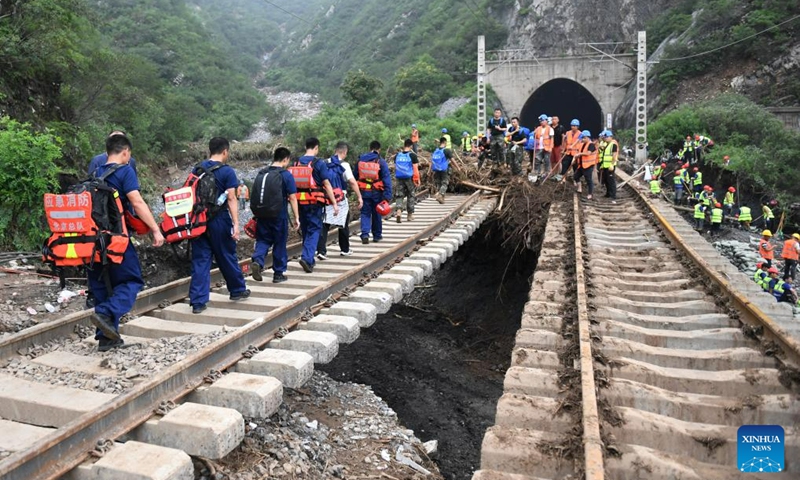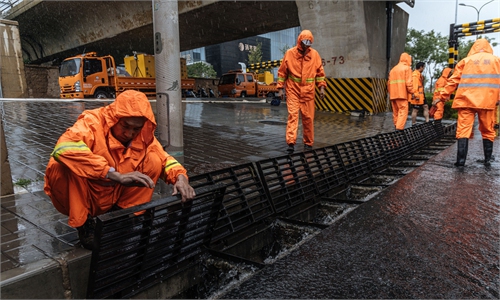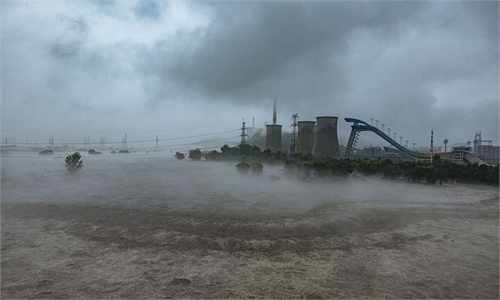Beijing rolls out restoration plan for areas damaged by floods
Experts call for attention to be paid to low-lying, mountainous areas in future urban planning

Rescuers walk to transfer stranded passengers in Mentougou District of Beijing, capital of China, Aug. 2, 2023. The last batch of stranded passengers of trains Z180 and K396 arrived at the Fengtai Railway Station in Beijing early in the morning on Aug. 3. Photo: Xinhua
A total of 33 people had died and 18 were still missing as of Tuesday in Beijing following severe flooding, a Beijing municipal government official confirmed on Wednesday, noting that Beijing had rolled out a plan for restoring affected areas in the capital, the first step of which is to restore the basic functions of conservancy facilities damaged by flooding.
Beijing will be fully engaged in post-disaster recovery and reconstruction work, executive vice mayor of Beijing Xia Linmao told a press conference on Wednesday.
Efforts will be made to finish the restoration of damaged hydraulic facilities, reinforcement of damaged houses of rural residents, and construction of infrastructure such as transportation, energy, communication, and public service facilities within a year to ensure the basic livelihood of local residents, according to Xia.
The restoration work is expected to be fully completed after three years. In a long-run, infrastructure and basic public services in affected areas will be comprehensively lifted up, Xia noted.
So far, Beijing authorities have conducted a systematic assessment of the restoration and reconstruction needs of water, transportation, electricity, communication, and other water-damaged infrastructure and drawn out a plan for the restoration.
The recent flooding has severely damaged some places in Beijing, but as authorities have issued timely early warnings and taken actions such as closing scenic spots and suspending some large-scale activities, more damage had been avoided, Ma Jun, director of the Beijing-based Institute of Public and Environmental Affairs, told the Global Times on Wednesday.
As to the work to restore infrastructure in affected areas in the future, Ma called for more review and attention be paid to low-lying and mountainous areas to prevent these places from being flooded in the future as heavy rainfall is expected to happen more often due to climate change.
Ma also noted the importance of networking as a vital part to enhance a modern city's response system to extreme weather events.
"Not only does our communication rely on a network, but meteorological monitoring and early warning mechanisms both require a strong network."
Affected by Typhoon Doksuri, the Chinese capital suffered extensive flooding caused by the heaviest rainfall in six decades from July 29 to August 2. Among the 18 people who were still missing as of Tuesday, five are volunteers and one is a rescuer, according to officials at the Wednesday press conference.
After reporting casualties, Beijing government officials expressed their deep condolences to the families of the comrades who sacrificed their lives in the line of duty and the victims. The conference attendees stood up for a moment of silence to pay tribute to the victims at the press conference.
According to Xia, 82,000 people across the city had been transferred as of 6 pm Tuesday. A total of 3,400 people and 2,400 facilities had been dedicated to repairing roads. As of Monday, 246 villages in affected areas have resumed traffic.
In the township of Liulihe in Beijing's Fangshan district, the Global Times encountered a detachment from the First Mobile Contingent of the PLA Armed Police Force actively engaged in rescue operations on August 3. Since the early hours of July 31, this PLA Armed Police Force had dispatched 54 personnel and 15 rescue vehicles, immediately embarking on missions such as search and rescue and material evacuation operations.



